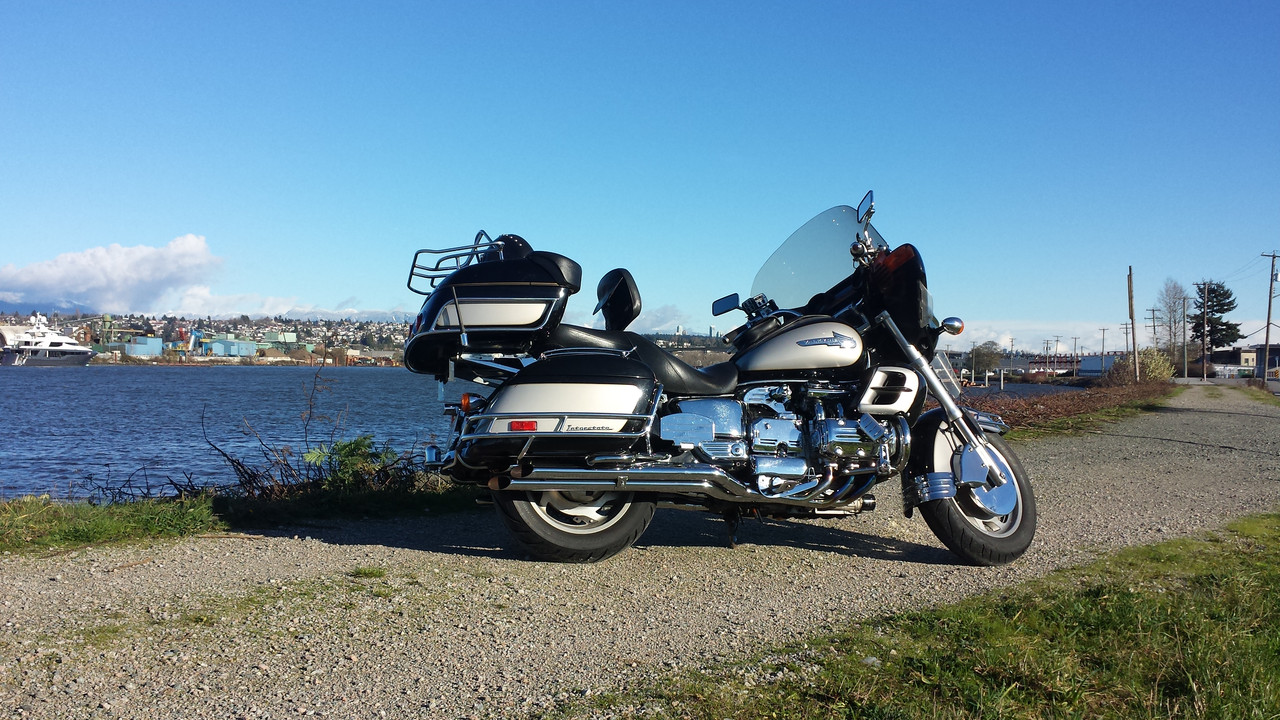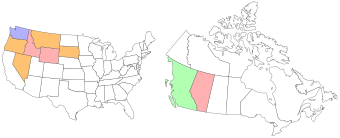MarcusS
Member
    
Posts: 311
New To Me August 2013
North Houston
|
 |
« on: January 12, 2016, 05:14:55 PM » |
|
I took a trip over the holidays out west and noticed significant power loss as I got higher. I went up about 6000 ft to the Davis Mountains from Houston. On the return trip when I stopped and took off at a light in Bastrop I spun my back tire just giving here the gas. Have others noticed the altitude power loss factor?
|
|
|
|
|
 Logged
Logged
|
Life goes on whether you are in it for the ride or not.
|
|
|
|
Bighead
|
 |
« Reply #1 on: January 12, 2016, 06:56:28 PM » |
|
I have ridden from coast to coast and up into Canada and have not noticed any difference that was noticeable with regular riding.
|
|
|
|
|
 Logged
Logged
|
1997 Bumble Bee
1999 Interstate (sold)
2016 Wing
|
|
|
gordonv
Member
    
Posts: 5766
VRCC # 31419
Richmond BC
|
 |
« Reply #2 on: January 12, 2016, 09:04:05 PM » |
|
It should change with the addition of local gas. The appropriate octane rated fuel for the altitude you are at. But most don't notice much of a change while passing through.
|
|
|
|
|
 Logged
Logged
|
1999 Black with custom paint IS   |
|
|
|
Savago
|
 |
« Reply #3 on: January 12, 2016, 09:58:09 PM » |
|
Dear Friend
I was really concerned with my I/S related to loss of power X altitude when I rode to Yellowstone (Bear tooth pass) and National Glacier Park (Going to the sun road).
Within *normal* riding, the loss of power was barely noticeable in both cases.
The funniest part: my I/S did 45 mpg in Bear Tooth pass (near 11000 feet == 3352m) and I got photos to prove it.
:-)
I guess this beasts like to run rich and are cold blooded.
Savago
|
|
|
|
|
 Logged
Logged
|
|
|
|
MarkT
Member
    
Posts: 5196
VRCC #437 "Form follows Function"
Colorado Front Range - elevation 2.005 km

|
 |
« Reply #4 on: January 12, 2016, 10:36:58 PM » |
|
Power loss is about 3% per thousand feet up for normally aspirated engines. Yeah you'll lose power but the good news is so does most everyone else (except turbos & blowers). You'll still have more than enough power to spank most of them. Many of us have ridden to the top of Mnt Evans - the highest road on the continent at 14,300 ft. Bike runs fine all the way up - but power reduced. Try this - get used to the power loss, then trailer to low altitude and ride. WAY more noticeable than the gradual change if you're riding it.
|
|
|
|
|
 Logged
Logged
|
|
|
|
|
..
|
 |
« Reply #5 on: January 13, 2016, 06:37:07 AM » |
|
Less oxygen in the air.
|
|
|
|
|
 Logged
Logged
|
|
|
|
|
..
|
 |
« Reply #6 on: January 13, 2016, 06:38:08 AM » |
|
It should change with the addition of local gas. The appropriate octane rated fuel for the altitude you are at. But most don't notice much of a change while passing through.
Yep, don't increase octane. That's why you see lower octane gas in the upper reaches of the mountain states. |
|
|
|
|
 Logged
Logged
|
|
|
|
|
Safety Steve
|
 |
« Reply #7 on: January 13, 2016, 12:56:05 PM » |
|
I was in Soda Springs for work over the summer and was at 6000 ft, I didn't notice a lost in power to tell the true my bike ran great, I did notice that when I had the choke on my bike RPM's wouldn't go above 2000 rpm, when I'm back home at 300 to 400 feet with choke the rpm's are about 2300.
and yes they like the cold.
I'm and Health & Safety Supervisor for my company and the first time I worked in Denver we had to message O2 levels so I called the manufacture of our O2 meter and asked him when the O2 levels in Denver where, he informed me that the O2 levels are the same that it is a pressure difference not a O2 difference..
|
|
|
|
|
 Logged
Logged
|
|
|
|
|
Safety Steve
|
 |
« Reply #8 on: January 13, 2016, 01:03:38 PM » |
|
Ok I check what I just typed and yes there is less O2 and less pressure.
|
|
|
|
|
 Logged
Logged
|
|
|
|
salty1
Member
    
Posts: 2359
"Flyka"
Spokane, WA or Tucson, AZ
|
 |
« Reply #9 on: January 13, 2016, 04:41:08 PM » |
|
Just did the Beartooth Pass last summer and my IS ran great. What are your pilots set at? Has your bike been desmogged? Bad gas, wrong octane, vacuum leaks, etc. ???
|
|
|
|
|
 Logged
Logged
|
My rides: 1998 GL1500C, 2000 GL 1500CF,2006 GL 1800 3A   |
|
|
h13man
Member
    
Posts: 1872
To everything there is an exception.
Indiana NW Central Flatlands
|
 |
« Reply #10 on: January 14, 2016, 08:19:16 AM » |
|
It seems the OP hit the magic altitude number @ 6500 ft.
As stated in the manual:
When the vehicle is continuously operated above 6500 ft., the carbs must be readjusted.
Warm engine to operating temperature and adjust pilot screws in 1/2 turn and turn idle speed down to 900 rpm. This procedure should be done @ high altitude.
Now even with that adjustment made it will still lose power the higher you go. Been to Mt. Evans a few times and 4 cyl. (auto) vehicles really suck by the time you get to the peak. 6 cyl. (auto) is the least I use to do the mountain touring.
Glad to see a Rocky Mt. rider post on this as hope to do the Rockies on the Valk in the near future. Been all over the Colorado Central Rockies but there are a few places I haven't been. If time will allow I plan to hop on US 24 5 mi. north of me and tour my way to the state of CO. And yes major cities will be bypassed.
|
|
|
|
« Last Edit: January 14, 2016, 08:20:56 AM by h13man »
|
 Logged
Logged
|
|
|
|
|
Moonshot_1
|
 |
« Reply #11 on: January 14, 2016, 04:47:43 PM » |
|
I took a trip over the holidays out west and noticed significant power loss as I got higher. I went up about 6000 ft to the Davis Mountains from Houston. On the return trip when I stopped and took off at a light in Bastrop I spun my back tire just giving here the gas. Have others noticed the altitude power loss factor?
Like others here I've been up through Beartooth Pass on an I/S and up to Pike's Peak @ 14k+ on my tourer. You do notice a loss of power. But I would never think to describe it as a "significant power loss" And this is at 14k feet. If you are experiencing significant power loss at 6k feet you may have other issues maybe as simple as a dirty air filter or as was said, poor gas or gas with a higher octane. But at 6k feet the power loss should be virtually unnoticeable. |
|
|
|
|
 Logged
Logged
|
Mike Luken
Cherokee, Ia.
Former Iowa Patriot Guard Ride Captain
|
|
|
gordonv
Member
    
Posts: 5766
VRCC # 31419
Richmond BC
|
 |
« Reply #12 on: January 14, 2016, 04:50:59 PM » |
|
Didn't think about the gas. If you are one of those who use 91 Octane fuel, and you've taken that up to the mountains and continue to use it, when the local Octane is now at 85, then you could be having this issue.
|
|
|
|
« Last Edit: January 14, 2016, 07:57:08 PM by gordonv »
|
 Logged
Logged
|
1999 Black with custom paint IS   |
|
|
|
Oldnick
|
 |
« Reply #13 on: January 15, 2016, 05:05:02 AM » |
|
It seems the OP hit the magic altitude number @ 6500 ft.
As stated in the manual:
When the vehicle is continuously operated above 6500 ft., the carbs must be readjusted.
Warm engine to operating temperature and adjust pilot screws in 1/2 turn and turn idle speed down to 900 rpm. This procedure should be done @ high altitude.
I am rusty, but IIRC this affects only the idle. Main performance is largely unaffected. Please correct me if the Valk is different. As I see it, you are sucking less mass of air into the pots. So you get less vacuum (less fuel cuscked) and also less O2 to help it burn. It's moot whether this causes richer or leaner running, but certainly will make fuel harder to burn. Go leanert (samller main jets, leaner burn and hotter?) or simply go lower octane for easier burn. If you are diving up and down, maybe just get used to reduced power when up; less risk of pre-ignition etc But hey I am on;ly a Valk trike rider, with 100Kg extra weight on its ass...don't talk to _me_ about reduced performance;  |
|
|
|
|
 Logged
Logged
|
Nick
May God save us from believers!
|
|
|
|

